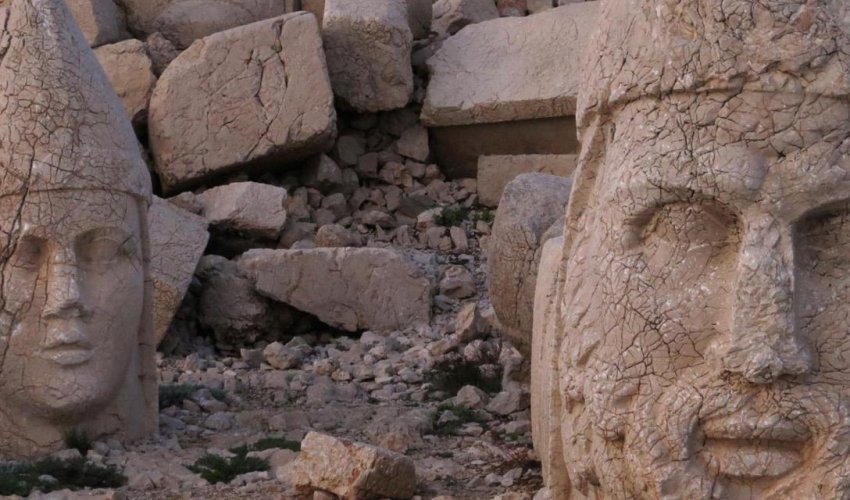Where gods and kings turn to stone

Massive statues of gods, kings and creatures stare down visitors to this little-known Unesco site in southeastern Turkey.
Silent GuardiansMassive statues of gods, kings and creatures stare down supplicants who travel to this tomb and Unesco World Heritage site. During the 1st Century BC, King Antiochus I ruled over a small kingdom called Commagene in what is today Turkey’s Adiyaman Province. When he died in approximately 34 BC, he was buried under a colossal mound of stones atop the windy peak of Mount Nemrut , which overlooks the upper Euphrates River. (Credit: Joseph Flaherty)
Resting among the godsAccording to inscriptions left behind before he died, Antiochus said he wanted to be buried in a high, isolated and holy place. By all accounts he succeeded: he built his own pantheon on this Olympian summit and entombed himself among the gods. Today, heads and rubble are all that remain of the giant stone statues that decorated the western terrace. (Credit: Joseph Flaherty)
Heavenly viewsA long, winding road to the summit hangs off the side of Mount Nemrut. Despite several hairpin turns, the path affords fantastic views of the surrounding craggy mountains. Nemrut is close to the southeastern section of the Taurus Mountain range, and visitors can access the ruins from the nearby cities of Adiyaman and Malatya. (Credit: Joseph Flaherty)
Icons from east and westThe east terrace of Mount Nemrut, known to archaeologists as the Hierothesion of Antiochus I, features mostly intact torsos of the gods, with their heads placed in front.
The pantheon of gods is of particular interest to historians for its blend of cultural and religious icons. It seems these statues served as a synthesis of the cultures that bordered the kingdom of Commagene: Persian and Zoroastrian religious figures, such as Zoroastrianism’s creator god and supreme deity Ahura Mazda, are combined with a Greek counterpart, such as Zeus. (Credit: Joseph Flaherty)
Caught between empiresAlthough Antiochus’ head today sits in front of his statue, he still cuts an imposing figure, flanked by an eagle and his kingdom’s patron goddess, Commagene.
Antiochus I reigned over the kingdom of Commagene from 69 BC, after he succeeded his father. One of several kingdoms that emerged following the division of Alexander the Great’s empire, Commagene occupied a small part of southeast Anatolia, sandwiched between other, larger kingdoms, including Rome to the west and Parthia to the east. (Credit: Joseph Flaherty)A tomb of pebblesThe 50m-high pile of what looks like small, nondescript stones is actually a pyramidal tomb structure (known as a tumulus) built for Antiochus. As king of Commagene, he was the progeny of a long line of royals from both the Hellenistic Seleucid Empire (on his mother’s side) and also the Achaemenids of Persia (on his father’s). (Credit: Joseph Flaherty)
An uncovered burial chamberCommagene came to an end when the Romans annexed the kingdom in 72 AD, 106 years after Antiochus died. His monument on Nemrut, however, went undiscovered until 1881, when German surveyors stumbled upon it. While archaeologists believe that Antiochus’ burial chamber lies beneath the mound of stones, the actual tomb has not been uncovered. Even with recent efforts using radar detection, researchers are cautious not to destroy the fragile pyramidal tumulus. (Credit: Joseph Flaherty)
Honouring AntiochusA lion sculpture guards a black slab of stone near the tomb’s eastern terrace. On this platform, celebrants burned ritual fires on feast days to celebrate the gods watching from their gigantic thrones a few metres away.
Of course, any offering to these gods honoured Antiochus too – the Commagene king cleverly inserted his statue next to the likenesses of Zeus in order to gain worshippers after he passed on. (Credit: Joseph Flaherty)
The origins of the EuphratesSharp-eyed climbers can spy the beginning of the Euphrates River, which starts in Adiyaman, moves south past the Turkish city of Gaziantep, crosses into Syria and finally spills into the Persian Gulf. Nemrut is also near the active East Anatolian fault line: Unesco is currently monitoring the site for fear that an earthquake could one day damage the already delicate sculptures or the tomb itself. (Credit: Joseph Flaherty)
Eye to the skyMount Nemrut reaches an elevation of 2,134m, and recent investigations have been exploring the possibility that the statues were oriented to line up with events in the lunar calendar. Astronomical significance aside, the peak offers spectacular views – both for earthly visitors and the watchful statues. (Credit: Joseph Flaherty)
(BBC)





www.ann.az
Similar news
Similar news
Latest news 
More news 



































 Photo
Photo 

 Video
Video 

